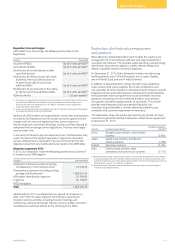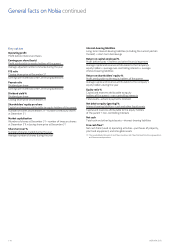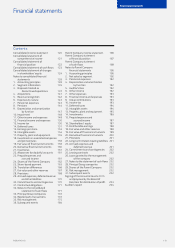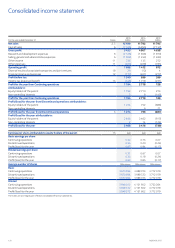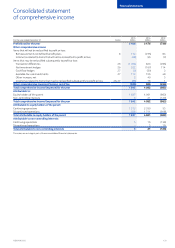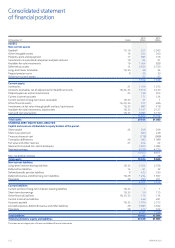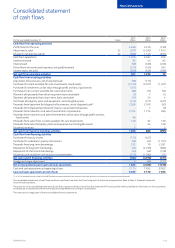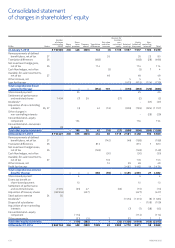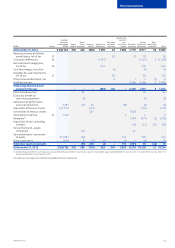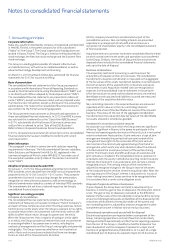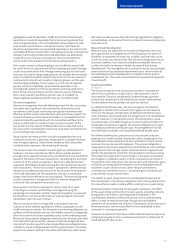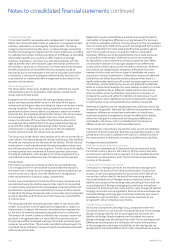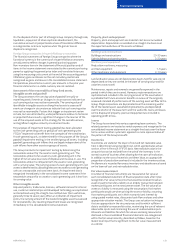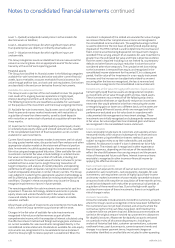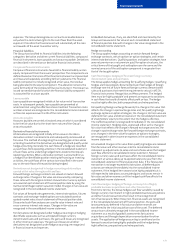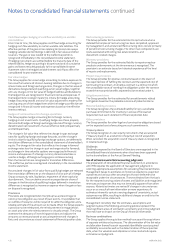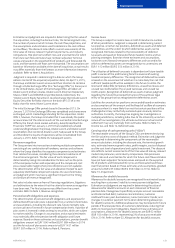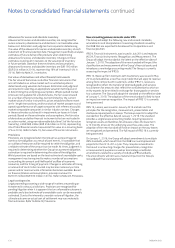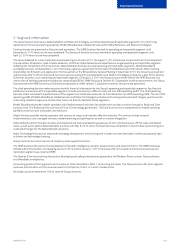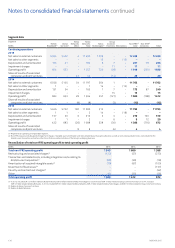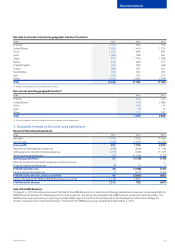Nokia 2015 Annual Report Download - page 129
Download and view the complete annual report
Please find page 129 of the 2015 Nokia annual report below. You can navigate through the pages in the report by either clicking on the pages listed below, or by using the keyword search tool below to find specific information within the annual report.
127
Financial statements
NOKIA IN 2015
geographical area of operations. Prot or loss from Discontinued
operations is reported separately from income and expenses from
Continuing operations in the consolidated income statement, with
prior periods presented on a comparative basis. Cash ows for
Discontinued operations are presented separately in the notes to the
consolidated nancial statements. Inter-group revenues and expenses
between Continuing and Discontinued operations are eliminated,
except for those revenues and expenses that are considered to
continue after the disposal of the Discontinued operations.
Non-current assets or disposal groups are classied as assets held
forsale if their carrying amounts will be recovered principally through
asale transaction rather than through continuing use. For this to be
the case, the asset or disposal group must be available for immediate
sale in its present condition subject only to terms that are usual and
customary for sales of such assets or disposal groups, and the sale
must be highly probable. These assets, or in the case of disposal
groups, assets and liabilities, are presented separately in the
consolidated statement of nancial position and measured at the
lower of the carrying amount and fair value less costs of disposal.
Non-current assets classied as held for sale, or included in a
disposalgroup classied as held for sale, are not depreciated.
Revenue recognition
Revenue is recognized when the following criteria for the transaction
have been met: signicant risks and rewards of ownership have
transferred to the buyer; continuing managerial involvement and
eective control usually associated with ownership have ceased; the
amount of revenue can be measured reliably; it is probable that the
economic benets associated with the transaction will ow to the
Group; and the costs incurred or to be incurred in respect of the
transaction can be measured reliably. Revenue is measured at the
fairvalue of the consideration received or receivable net of discounts
and excluding taxes and duties.
Recurring service revenue which includes managed services and
maintenance services is generally recognized on a straight-line basis
over the agreed period, unless there is evidence that some other
method better represents the rendering of services.
The Group enters into contracts consisting of any combination of
hardware, services and software. Within these multiple element
arrangements, separate components are identied and accounted for
based on the nature of those components, considering the economic
substance of the entire arrangement. Revenue is allocated to each
separately identiable component based on the relative fair value of
each component. The fair value of each component is determined by
taking into consideration factors such as the price of the component
when sold separately and the component cost plus a reasonable
margin when price references are not available. The revenue allocated
to each component is recognized when the revenue recognition
criteria for that component have been met.
Revenue from contracts involving the construction of an asset
according to customer specications is recognized using the
percentage of completion method. Stage of completion is measured
by reference to cost incurred to date as a percentage of estimated
total project costs for each contract.
Revenue on license fees is recognized in accordance with the
substance of the relevant agreements. Where, subsequent to the
initial licensing transaction, the Group has no remaining obligations to
perform and licensing fees are non-refundable, revenue is recognized
after the customer has been provided access to the underlying asset.
Where the Group retains obligations related to the licensed asset after
the initial licensing transaction, revenue is typically recognized over
aperiod of time during which remaining performance obligations are
satised. In some multiple element licensing transactions, the Group
applies the residual method in the absence of reference information.
Net sales includes revenue from all licensing negotiations, litigations
and arbitrations to the extent that the criteria for revenue recognition
have been met.
Research and development
Research costs are expensed as incurred. Development costs may
berecognized as an intangible asset if the Group has the technical
feasibility to complete the asset; has an ability and intention to use
orsell the asset; can demonstrate that the asset will generate future
economic benets; has resources available to complete the asset;
andhas the ability to measure reliably the expenditure during
development. The intangible asset is carried at cost less accumulated
amortisation and accumulated impairment losses. Amortisation of
theasset begins when development is complete and the asset is
available for use. The asset is amortised over the period of expected
future benet.
Employee benets
Pensions
The Group companies have various pension plans in accordance
withthe local conditions and practices in the countries in which
theyoperate. The plans are generally funded through payments
toinsurance companies or contributions to trustee-administered
funds as determined by periodic actuarial calculations.
In a dened contribution plan, the Group’s legal or constructive
obligation is limited to the amount that it agrees to contribute to
thefund. The Group’s contributions to dened contribution plans,
multi-employer and insured plans are recognized in the consolidated
income statement in the period to which the contributions relate.
Ifapension plan is funded through an insurance contract where the
Group does not retain any legal or constructive obligations, the plan
istreated as a dened contribution plan. All arrangements that do
notfulll these conditions are considered dened benet plans.
For dened benet plans, pension costs are assessed using the
projected unit credit method: the pension cost is recognized in the
consolidated income statement so as to spread the current service
cost over the service lives of employees. The pension obligation is
measured as the present value of the estimated future cash outows
using interest rates on high-quality corporate bonds or government
bonds with appropriate maturities. Actuarial gains and losses arising
from experience adjustments and changes in actuarial assumptions
are charged or credited to equity in other comprehensive income in
the period in which they arise. Past service costs and settlement gains
and losses are recognized immediately in the consolidated income
statement as part of service cost, when the plan amendment,
curtailment or settlement occurs. Curtailment gains and losses are
accounted for as past service costs.
The liability or asset recognized in the consolidated statement of
nancial position is the pension obligation at the closing date less the
fair value of plan assets including eects relating to any asset ceiling.
Remeasurements, comprising actuarial gains and losses, the eect
ofthe asset ceiling and the return on plan assets, excluding amounts
recognized in net interest, are recognized immediately in the
consolidated statement of nancial position with a corresponding
debit or credit to retained earnings through the consolidated
statement of comprehensive income in the period in which they occur.
Remeasurements are not reclassied to the consolidated income
statement in subsequent periods.
Actuarial valuations for the Group’s dened benet pension plans are
performed annually or when a material curtailment or settlement of
adened benet plan occurs.


